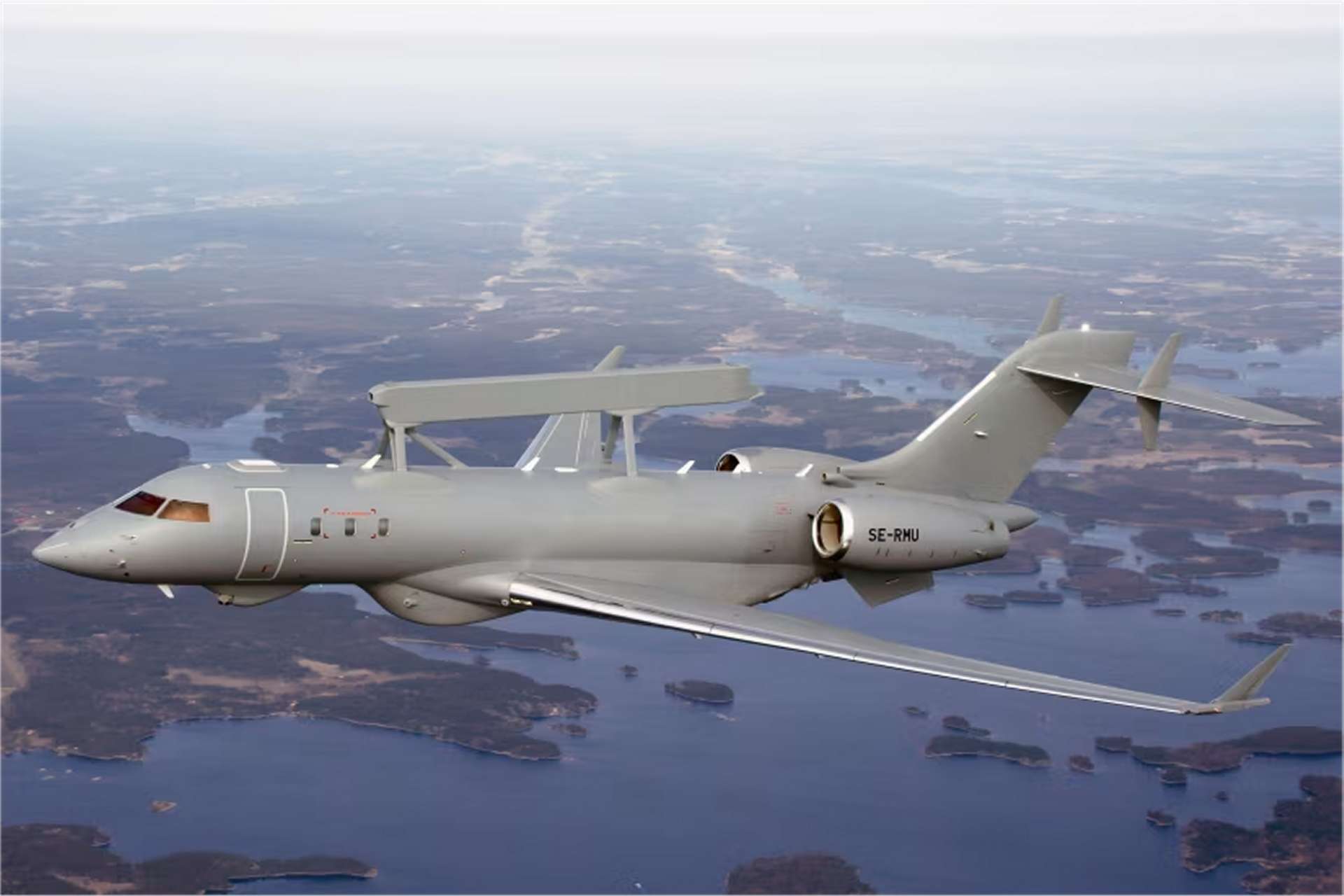Saab Delivers Fifth GlobalEye AEW&C Aircraft to UAE

{loadposition bannertop}
{loadposition sidebarpub}
On September 17, 2024, Saab completed the delivery of the fifth and final GlobalEye aircraft to the United Arab Emirates (UAE) Air Force, marking the culmination of a series of deliveries that began in 2020. This milestone confirms Saab’s leadership in advanced airborne surveillance and control. Carl-Johan Bergholm, head of Saab’s Surveillance division, highlighted the effectiveness of the partnership with the UAE Air Force, which has enabled the rapid development, production, and delivery of this advanced fleet, thereby enhancing Saab’s stature in the international market.Follow Army Recognition on Google News at this link
SAAB GlobalEye Multi-Domain Airborne Early Warning and Control, AEW&C (Picture source: SAAB)
The GlobalEye is a multi-domain Airborne Early Warning and Control (AEW&C) platform that incorporates both active and passive sensors on the Bombardier Global 6000/6500 business jet. This setup provides operational autonomy of more than 11 hours and the capability to operate from runways as short as 6500 feet, facilitating the use of smaller airports. The enhanced Erieye ER radar system and other advanced sensors allow for increased detection and tracking, even under heavy jamming conditions, offering superior maritime and aerial surveillance. Key capabilities include detecting maritime targets up to the horizon and small boats at long distances, with features such as Automatic Identification System (AIS), Electro-Optical System (EOS), and Inverse Synthetic Aperture Radar (ISAR).
The GlobalEye can perform multiple roles simultaneously and switch between these roles at any point during a mission, making it highly versatile. It was first ordered by the United Arab Emirates (UAE) in 2015 with a contract worth $1.27 billion to provide a new generation of airborne swing-role surveillance systems. The aircraft is capable of operating from short runways, offers low noise levels, and features ergonomic seating for operators, highlighting its design for long-duration missions and operator comfort.
Simultaneously, Sweden has also chosen this aircraft to enhance its fleet by ordering a third GlobalEye, increasing its strategic surveillance and reconnaissance capabilities. This addition follows an initial contract in 2022 for two aircraft, with an option for two more, reflecting an ongoing enhancement of Swedish defense, emphasizing the growing importance of regional surveillance in Northern Europe and the Baltic states. These aircraft, designated S 106 in Sweden, will play a crucial role in modernizing the Swedish armed forces, significantly improving their ability to monitor and respond to potential threats.
France is also currently nearing the final stages of acquiring the GlobalEye airborne early warning and control (AEW&C) aircraft from Saab. This move is aimed at replacing France’s aging fleet of E-3F Sentry AWACS (Airborne Warning and Control System) aircraft, which have been a crucial component of the French Air Force since 1991. The GlobalEye is chosen for its advanced capabilities, featuring the Erieye active electronically scanned array radar which provides a significantly extended range of operation over air, sea, and land domains.
The completion of deliveries to the UAE and the expansion of the Swedish fleet demonstrate the strategic impact of the GlobalEye as a global surveillance asset, enhancing the national security of the user countries. This platform, capable of operating in peace, crisis, or conflict, represents an essential tool for defense and international security.
The GlobalEye system is based on the Bombardier Global 6000 aircraft, known for its endurance, operational range, and ability to operate from shorter runways, making it ideal for regions like the Middle East, where geographic and operational conditions vary. The aircraft’s endurance and sensor capabilities make it particularly effective for extensive area surveillance, crucial for the UAE given its strategic geographic positioning and regional security responsibilities.
Additionally, the partnership with Saab includes not only the procurement of the aircraft but also a comprehensive support package involving maintenance, logistics, and training. This ensures that the GlobalEye systems remain operationally effective and are well-integrated into the UAE’s defense infrastructure. This arrangement also supports the development of local expertise and the long-term sustainability of the defense system.

{loadposition bannertop}
{loadposition sidebarpub}
On September 17, 2024, Saab completed the delivery of the fifth and final GlobalEye aircraft to the United Arab Emirates (UAE) Air Force, marking the culmination of a series of deliveries that began in 2020. This milestone confirms Saab’s leadership in advanced airborne surveillance and control. Carl-Johan Bergholm, head of Saab’s Surveillance division, highlighted the effectiveness of the partnership with the UAE Air Force, which has enabled the rapid development, production, and delivery of this advanced fleet, thereby enhancing Saab’s stature in the international market.
SAAB GlobalEye Multi-Domain Airborne Early Warning and Control, AEW&C (Picture source: SAAB)
The GlobalEye is a multi-domain Airborne Early Warning and Control (AEW&C) platform that incorporates both active and passive sensors on the Bombardier Global 6000/6500 business jet. This setup provides operational autonomy of more than 11 hours and the capability to operate from runways as short as 6500 feet, facilitating the use of smaller airports. The enhanced Erieye ER radar system and other advanced sensors allow for increased detection and tracking, even under heavy jamming conditions, offering superior maritime and aerial surveillance. Key capabilities include detecting maritime targets up to the horizon and small boats at long distances, with features such as Automatic Identification System (AIS), Electro-Optical System (EOS), and Inverse Synthetic Aperture Radar (ISAR).
The GlobalEye can perform multiple roles simultaneously and switch between these roles at any point during a mission, making it highly versatile. It was first ordered by the United Arab Emirates (UAE) in 2015 with a contract worth $1.27 billion to provide a new generation of airborne swing-role surveillance systems. The aircraft is capable of operating from short runways, offers low noise levels, and features ergonomic seating for operators, highlighting its design for long-duration missions and operator comfort.
Simultaneously, Sweden has also chosen this aircraft to enhance its fleet by ordering a third GlobalEye, increasing its strategic surveillance and reconnaissance capabilities. This addition follows an initial contract in 2022 for two aircraft, with an option for two more, reflecting an ongoing enhancement of Swedish defense, emphasizing the growing importance of regional surveillance in Northern Europe and the Baltic states. These aircraft, designated S 106 in Sweden, will play a crucial role in modernizing the Swedish armed forces, significantly improving their ability to monitor and respond to potential threats.
France is also currently nearing the final stages of acquiring the GlobalEye airborne early warning and control (AEW&C) aircraft from Saab. This move is aimed at replacing France’s aging fleet of E-3F Sentry AWACS (Airborne Warning and Control System) aircraft, which have been a crucial component of the French Air Force since 1991. The GlobalEye is chosen for its advanced capabilities, featuring the Erieye active electronically scanned array radar which provides a significantly extended range of operation over air, sea, and land domains.
The completion of deliveries to the UAE and the expansion of the Swedish fleet demonstrate the strategic impact of the GlobalEye as a global surveillance asset, enhancing the national security of the user countries. This platform, capable of operating in peace, crisis, or conflict, represents an essential tool for defense and international security.
The GlobalEye system is based on the Bombardier Global 6000 aircraft, known for its endurance, operational range, and ability to operate from shorter runways, making it ideal for regions like the Middle East, where geographic and operational conditions vary. The aircraft’s endurance and sensor capabilities make it particularly effective for extensive area surveillance, crucial for the UAE given its strategic geographic positioning and regional security responsibilities.
Additionally, the partnership with Saab includes not only the procurement of the aircraft but also a comprehensive support package involving maintenance, logistics, and training. This ensures that the GlobalEye systems remain operationally effective and are well-integrated into the UAE’s defense infrastructure. This arrangement also supports the development of local expertise and the long-term sustainability of the defense system.





